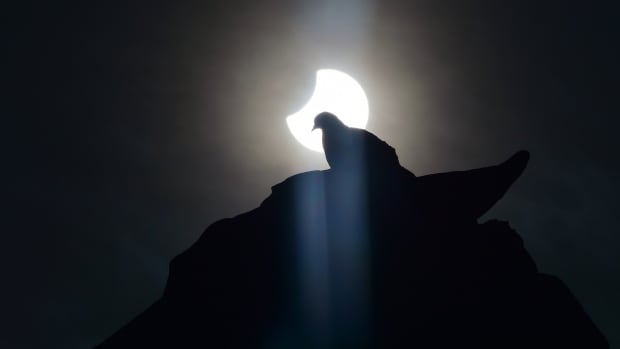As ominous as it may look, the total eclipse of the sun in early April will not cause a frenzy in the animal kingdom.
But portents aside, a solar eclipse does have an effect on birds, insects and others, because of how much these animals depend on the sun for orientation.
“Light is such a ubiquitous cue,” said Cecilia Nilsson, who studies bird and insect movement at Lund University in Sweden.
“But it’s also a cue that’s very hard to manipulate in any way, as a researcher. You can’t really turn the sun off and on.”
That’s why she and a team of researchers used the last eclipse that shaded parts of the United States, in August 2017, to study bird and insect movement. They used a weather surveillance radar network, and the stations collect continuous data, which tell us about the weather but can also pick up biological signatures, such as migrating birds.
The birds…
The team’s hypothesis was that some birds would take to the skies during the eclipse, because sunset during the autumn migration season is often when some flocks get going.

“They did not do that at all,” Nilsson told CBC News from Lund, Sweden. “The activity in the air decreased. So they were actually moving around a lot less and there were less birds in the air.”
In fact, leading up to the eclipse’s totality, the birds started exhibiting a wind-down behaviour. Nilsson theorizes they perceived the dimming sky as a gathering storm, which would be dangerous to fly in. But any effects went away when the sun came back about three minutes later.
“It was kind of like a ‘huh?’ moment … and then pretty quickly returning to the normal,” Nilsson said.
… And the bees
Nilsson’s research did suggest something happened at the moment of totality, with a few radar stations picking up “sudden peaks in the numbers of biological targets at low altitudes.”
The theory is that nocturnal insects, which respond much more rapidly to the onset of night, became active. It’s long been known, for example, that honeybees depend on the sun for navigation — it was in fact a Nobel Prize-winning revelation, says Dezene Huber, a professor at the University of Northern British Columbia.
“The orientation of the dance on the comb relates to the orientation of the sun outside of the hive,” said Huber. This allows the entire hive to know how to get to food.
He says depending on when these insects are active — whether they’re diurnal or nocturnal — an eclipse might elicit different responses. For example, animals that are active during the day might take the same hunker-down approach, as the eclipse might present like storm conditions.

“I would expect that some insects like honeybees might have some trouble navigating briefly,” Huber told CBC News from Prince George, B.C. But life soon resumes, as these animals also have other ways of judging the sun’s position in the sky.
“When it brightens up again, they’ll simply be able to carry on with their route towards the flowers or back towards the hive,” Huber explained.
Hugh Danks, a retired entomologist, agrees.
“These temporary effects of a solar eclipse are not likely to be much more dramatic than the ‘ordinary’ effects of weather changes,” Danks wrote in an email to CBC News.
Rare opportunity
Beyond birds and insects, zoos along the path of totality have a unique chance to see how bigger animals react to the sun going out. The Granby Zoo, east of Montreal, will be closed to the public so researchers can observe those dark, precious minutes.
Granby Zoo, located an hour outside Montreal, will close on April 8 to observe how 10 species behave, before, during and after the rare event.
“We’re going to see if the animals go towards their night habitats, if some of them are going to vocalize,” said Chelsey Paquette, a conservation co-ordinator with the zoo. She expects some animals to be more vocal than others.
“Japanese macaques are probably going to go a little bit crazy,” Paquette suggested. “We think that they might vocalize, huddle in the group together. They might actually look at the sun, or lack thereof.”
Many other zoos along the eclipse path are also gearing up for study. Granby Zoo is in touch with a zoo in Texas to compare data.

Longer-term disruption
Regardless of any initial changes in behaviour, experts say the eclipse is a momentary pause in patterns — and that these species face many longer-term dangers.
Huber said that includes “climate change, being as rapid as it is, [layered] with development, pesticide use and habitat destruction, and we’re seeing massive changes out there.”
WATCH | 1 in 5 migratory species at risk of extinction: UN:
A new United Nations report says that almost half of the world’s migratory animals are in decline and that many birds and fish are at risk of extinction.
A recent UN report says climate change is affecting migratory species, as is habitat loss and over-exploitation.
Huber says studying animals during an eclipse is more of an “intellectual exercise.”
“These small-scale things that are happening have nothing compared to some of the large-scale things that we as humans are doing,” he said.









